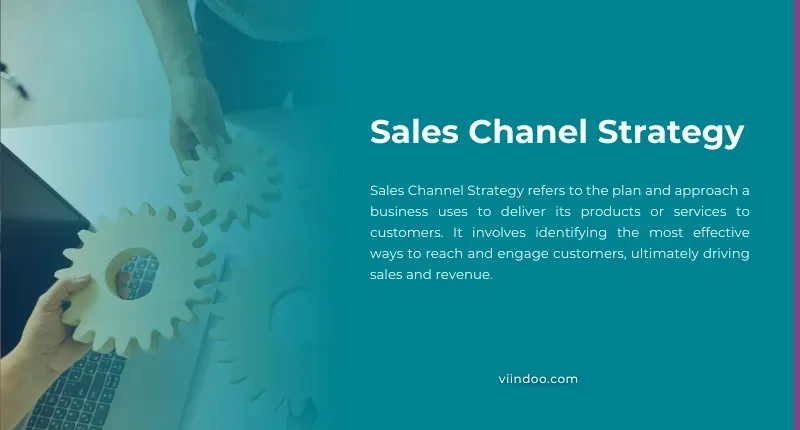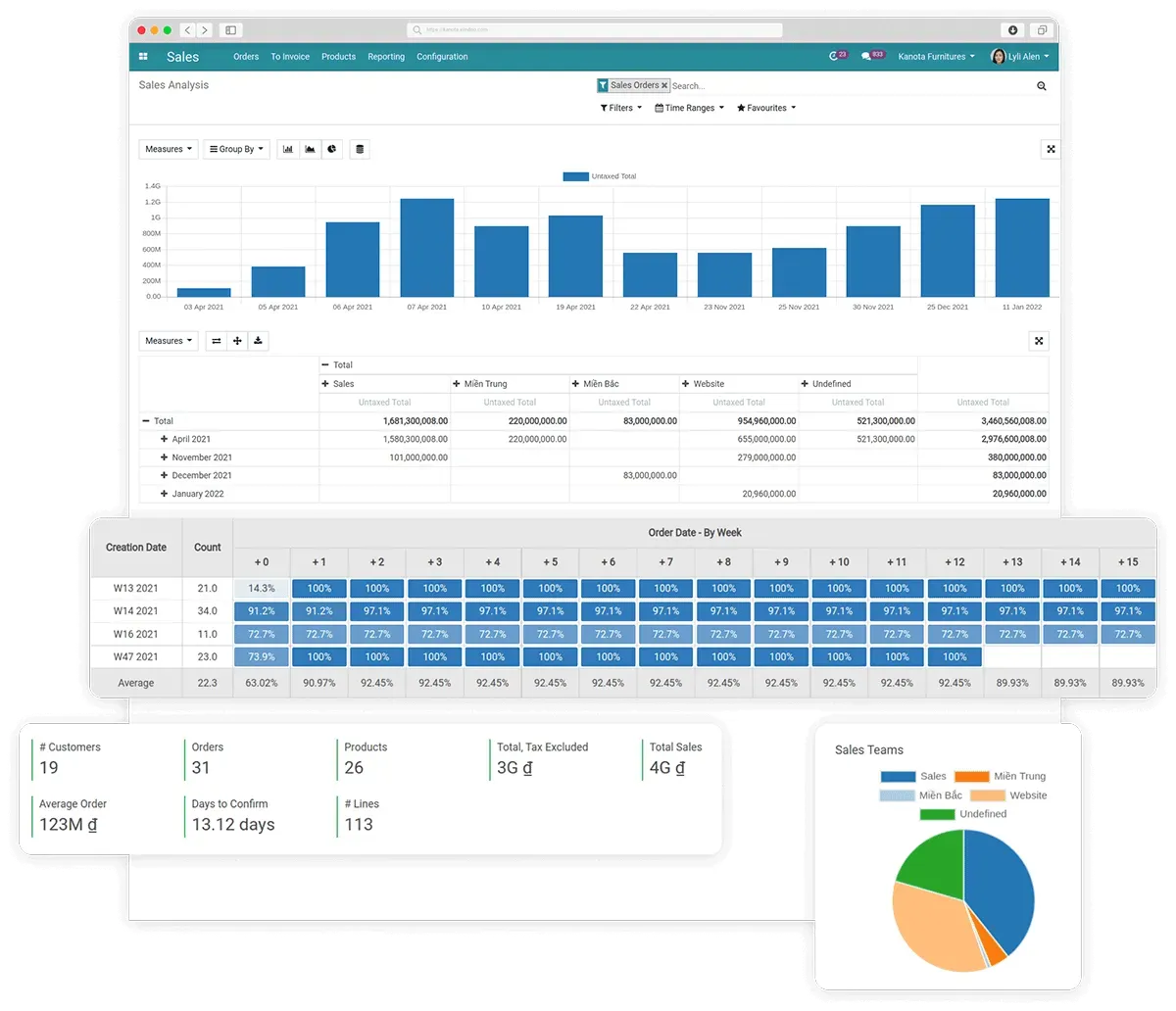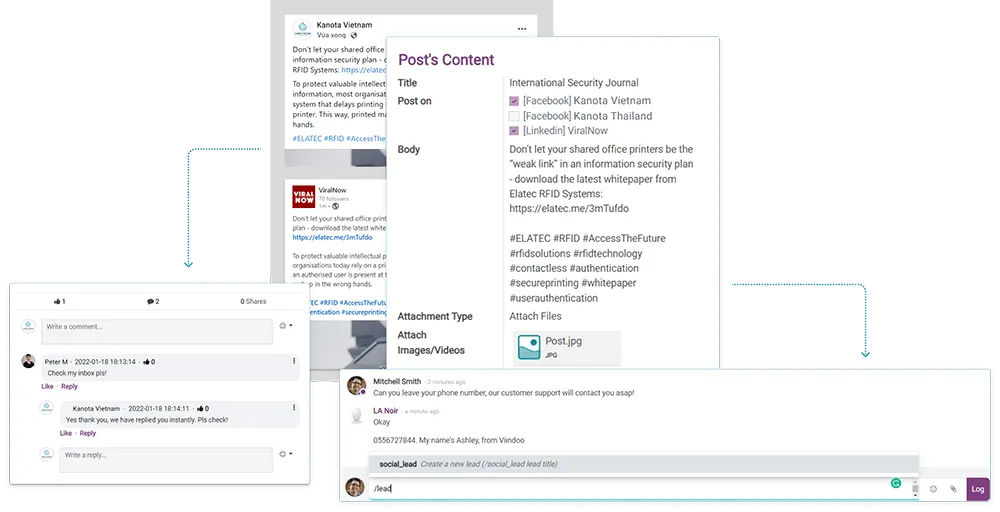In today's business landscape, crafting a successful sales channel strategy is more than just bringing products or services to the market. It's about establishing a seamless connection between businesses and customers. To achieve this, understanding and shaping the critical components of a sales channel strategy becomes imperative.
In this article, we will delve into the key elements that a dependable sales channel strategy should encompass. From identifying target markets and customer segmentation to selecting appropriate distribution channels, every aspect contributes to building a robust strategy. We will also explore showcasing product value through each channel, managing relationships with partners and customers, and ensuring adaptability and flexibility in an ever-evolving environment.
Below, let's embark on a detailed exploration of these pivotal factors and how they collectively form a potent sales channel strategy.
What is a Sales Chanel Strategy?

What is sales channel strategy?
Sales Channel Strategy refers to the plan and approach a business uses to deliver its products or services to customers. It involves identifying the most effective ways to reach and engage customers, ultimately driving sales and revenue. A well-defined sales funnel strategy takes into account a variety of factors, including the target market, customer preferences, industry trends, and the competitive landscape.
Sales Channel Strategy and Sales Strategy are mutually supportive and complementary in two essential aspects of the sales process at a business.
- Sales Strategy: the overall plan a business uses to go to market, establish relationships with customers, and maximize sales. It includes decisions related to customer targeting, lead generation, sales process management, pricing, promotions, and after-sales support. Sales strategy shapes how a business engages and interacts with customers to drive purchases and generate profits.
- Sales Channel Strategy: Channel strategy is a component of an overall sales strategy and focuses on how a business uses specific channels to deliver its products or services to customers. This includes defining sales channels such as direct sales, online sales, retail partnerships, distribution networks or e-commerce platforms. Sales funnel strategy defines how to organize and deliver products, how to manage channel partnerships, and how to create a convenient and efficient shopping experience for customers.
The relationship between these two aspects is that a sales channel strategy is a crucial part of the broader sales strategy. An effective sales strategy will require a corresponding sales channel strategy to ensure that products or services are effectively and appropriately brought to market
For example, if a sales strategy is geared towards targeting large businesses, the sales channel strategy might involve collaborating with distribution partners to integrate products into their supply chains. Conversely, if the sales strategy is focused on individual consumers, the sales channel strategy might emphasize using e-commerce platforms and online advertising to reach the target audience.
The Key Elements of a Successful Sales Channel Strategy

Identify target market
Understand your ideal customer profile and segment your target market based on demographics, behaviors, needs, and preferences.
This helps tailor your sales channels to effectively reach different customer segments.

Product/Service Offering
Determine which products or services are best suited for each sales channel. Some offerings may be better suited for direct sales, while others may perform well through online marketplaces or third-party retailers.

Channel Mix
Decide on the mix of sales channels you will use, such as direct sales (in-person or online), retail partnerships, e-commerce platforms, distributors, resellers, wholesalers, and more.
The combination of channels should align with your target market and business objectives.

Online Presence
Consider the role of online sales channels, including your website, e-commerce platforms, and social media. An effective online presence is crucial for reaching and engaging customers in today's digital age.

Branding and Messaging
Develop consistent branding and messaging across all sales channels to create a cohesive customer experience and reinforce your value proposition.

Channel partnerships
When leveraging third-party retail or distribution channels, partnerships are key. Build a trusted bond and partnership with your partners, and provide the support, training, and encouragement they need to represent your brand effectively.

Customer Experience
Focus on delivering a seamless and positive customer experience across all channels. This includes providing excellent customer service, easy purchasing processes, and efficient post-sales support.

Data and analytics
Implement tracking and analytics tools to track the performance of each sales channel. This data-driven approach will help you identify what's working and make smart decisions to optimize your business strategy over time.

Adaptability and Flexibility
The market and customer preferences can change, so be prepared to adjust your sales channel strategy as needed to stay relevant and competitive.

Competitor Analysis
Research your competitors' sales channel strategies to identify potential gaps or opportunities in the market. Differentiating your approach can give you a competitive edge.

Resource allocation
Allocate resources such as budget, manpower, and technology appropriately to support the execution of your sales channel strategy.

Testing and Optimization
Continuously test and refine your sales channels to optimize their performance. Experiment with different approaches, gather feedback, and iterate based on the results.
Remember that an effective sales channel strategy is not one-size-fits-all and should be tailored to your specific business goals and market conditions. Regularly reviewing and adapting your strategy will help ensure long-term success in reaching and engaging your target customers.

How to build a sales channel strategy

How to build a sales channel strategy
Involves a systematic process that takes into account your business goals, target market, products or services, and competitive landscape. Here's a step-by-step guide to help you develop an effective sales channel strategy:
Set Clear Business Objectives
Define your business objectives, such as revenue targets, market expansion, or product penetration. Your sales channel strategy should align with these goals.
Understand your target market
Conduct thorough market research to understand your target audience's demographics, preferences, behaviors, and buying habits. This insight will help you tailor your sales channels to effectively reach and engage them.
Segmentation
Divide your target market into segments based on common characteristics and needs. This segmentation will guide the selection and customization of sales channels for different customer groups. Great stories have a personality. Consider telling a great story that provides personality. Writing a story with personality for potential clients will assist with making a relationship connection. This shows up in small quirks like word choices or phrases. Write from your point of view, not from someone else's experience.
Analyze Competitors
Study your competitors' sales channel strategies to identify strengths, weaknesses, opportunities, and threats. This analysis can inform your own strategy and help you differentiate yourself in the market.
Product or Service Analysis
Determine which products or services are best suited for each sales channel. Consider factors like complexity, pricing, and customer buying preferences.
Select Sales Channels
Choose the appropriate mix of sales channels based on your target market and product characteristics. Options may include direct sales (online or in-person), distributors, retailers, e-commerce platforms, or a combination of these.
Channel Partner Selection
If working with channel partners, carefully select partners that align with your brand values, have a strong customer base, and offer complementary products or services.
Value Proposition and Messaging
Develop consistent messaging and value propositions for each sales channel to ensure a cohesive brand image and customer experience.
Pricing Strategy
Determine how you will price your products or services in each channel, considering factors such as distribution costs, competitor pricing, and perceived value.
Channel Support and Training
Provide training and support to channel partners to ensure they have the knowledge and tools to effectively sell your products or services.
Sales Forecasting
Estimate sales volumes for each channel based on historical data, market trends, and channel performance.
Resource Allocation
Allocate resources such as budget, personnel, and technology to support the execution of your sales channel strategy.
Implementation Plan
Create a detailed plan outlining the steps required to launch and manage each sales channel. Assign responsibilities and set timelines for implementation.
Testing and Iteration
Pilot your sales channel strategy and gather feedback. Monitor performance and make necessary adjustments based on customer response and sales results.
Data Analytics and Monitoring
Implement tracking and analytics tools to measure the success of each channel. Regularly review key performance indicators (KPIs) and adjust your strategy as needed.
Continuous Improvement
Regularly assess and refine your sales channel strategy based on market changes, customer feedback, and business goals.
Adaptability
Be prepared to adapt your strategy as market dynamics evolve and new opportunities arise.
Remember that a successful sales channel strategy is not static; it requires ongoing monitoring, flexibility, and optimization to ensure that it continues to meet the needs of your business and your target customers.
Building a Sales Channel Strategy with Viindoo

Viindoo Sales to build sales strategy
Using Viindoo to develop a detailed sales channel strategy involves the integration of various functionalities within Viindoo, thorough analysis, and ongoing adjustments. Below are the specific steps to implement this process:
Data Collection and Analysis
- Utilize Viindoo functions related to customer management and sales data to gather information on customers, sales figures, profits, and other relevant factors.
- Apply analytical tools within Viindoo to conduct an in-depth analysis of the current performance of sales channels. Identify which channels contribute significantly to revenue and profits, channels with high conversion rates, and areas requiring improvement.

Identify Target Customers and Market Segmentation
Using the CRM and Sales Management system in Viindoo, allows you to have the following information:
- Integrated customer data: Viindoo has the ability to integrate customer data from various sources, including purchases, online interactions, contact information, and more. This creates a comprehensive source of information about the customer.
- Advanced data analytics: Viindoo provides advanced analytics tools to identify patterns and trends in customer data.
- Create Custom Segments: Based on analytics, Viindoo allows you to create custom customer segments based on criteria like age, gender, geography, purchasing behavior and many more. This helps you to clearly define distinct target groups.
- Business Integration: Viindoo connects customer data with other business operations such as order management, inventory control and marketing. This creates a holistic view of the customer across multiple facets.
- Customer interaction tracking: Viindoo system allows to track customer interactions with businesses across various channels, including phone calls, emails, websites and social media. This helps you understand how customers interact with your brand.
- Generate Statistical Reports: Viindoo provides the ability to generate statistical reports on customer segments that shape the sales funnel strategy and allow for adjustments based on specific information.
- Marketing integration: Viindoo integrates customer segmentation and data with marketing campaigns, allowing the creation of tailored messages and campaigns based on the interests and behaviors of each customer group.
- Multidimensional data classification: Viindoo allows classifying customer data in many different dimensions such as product type, time, geographical area, etc. This helps to identify trends and patterns in purchasing behavior.
- Process automation: Viindoo can automate customer-related processes, such as sending welcome emails, discount notifications, or order tracking. This enhances customer interaction and management.
Using Viindoo to identify target customers and perform market segmentation optimizes data management, captures valuable customer insights, and builds key sale funnel strategies more accurate and efficient.
Channel Selection
- Based on customer data and channel performance insights from Viindoo, make informed decisions about which specific sales channels to utilize for each customer segment.
- Determine the most suitable channels for reaching and engaging with each customer group, such as direct sales, agents, online platforms, or retail.
Product and Inventory Management
- Centralized Product Information: Viindoo provide a centralized repository for storing detailed product information, including descriptions, specifications, pricing, and related documentation. This ensures that accurate and consistent product data is accessible to all relevant departments.
- Product Lifecycle Management: Viindoo facilitates end-to-end product lifecycle management, from product development and introduction to retirement. This helps businesses track product versions, updates, and changes over time.
- Inventory tracking: Viindoo enables real-time tracking of inventory levels across multiple locations, warehouses, and distribution centers. This helps prevent overstocking or stockouts and ensures optimal inventory levels are maintained...
- Demand Forecasting: Viindoo can integrate historical sales data and trends to provide insights for accurate demand forecasting. This assists in aligning production and procurement with actual demand.
- Supplier Management: Viindoo offer features for managing supplier relationships, including supplier performance, lead times, and communication. This ensures a smooth supply chain process and minimizes disruptions.
- Order Management: Viindoo streamline order processing by integrating customer orders, inventory reorder point, and order fulfillment. This reduces errors and delays in order fulfillment.
- Automated Replenishment: Viindoo can automate replenishment processes by triggering purchase orders or production orders based on predefined inventory thresholds. This helps maintain optimal safety stock without manual intervention.
- Batch and Serial Number Tracking: For industries requiring batch or serial number tracking (e.g., electronics, pharmaceuticals), Viindoo offers tools to trace products throughout the supply chain and maintain compliance.
- Reporting and Analytics: Viindoo generates comprehensive reports and analytics related to product performance, inventory turnover, sales trends, and more. These insights aid in making informed decisions.
- Reduced Operational Costs: By optimizing inventory levels, improving order accuracy, and increasing supply chain visibility, Viindoo contributes to reducing operational costs.

Adjust Channel Strategy
- The integration of Viindoo with the process of adjusting a channel strategy can greatly enhance a business's ability to make informed decisions and optimize its sales and distribution efforts. By leveraging the functionalities of Viindoo, companies can efficiently adapt their channel strategies in response to changing market dynamics.
- Incorporating Viindoo into the process of adjusting a channel strategy empowers businesses with data-driven insights, streamlined operations, and the agility needed to respond effectively to market shifts.
- This integration helps companies maximize the potential of each sales channel, optimize resource allocation, and maintain a competitive edge in a rapidly changing business landscape.
Process Optimization
- Utilize Viindoo capabilities to optimize processes related to each sales channel, including order processing, delivery, customer management, and post-sales support.
- Ensure smooth and efficient operations to deliver a positive customer experience across all channels.
Communication
- Use customer data and interaction history from Viindoo to establish and maintain relationships with customers through various communication channels such as email, phone, website, and social media.
Continuous Feedback Loop
Integrating the Viindoo system with a continuous feedback loop is a powerful approach to driving continuous improvement, optimization and agility within an organization. The continuous feedback loop involves collecting, analyzing, and acting on feedback from a variety of sources to drive improvements. When combined with the Viindoo system, it creates a dynamic environment for repeated screening. Here's how Viindoo can work with a continuous feedback loop:
- Data collection and tracking: Viindoo automatically collects large amounts of data related to operations, sales, inventory, customer interactions, and more. This data serves as the foundation for identifying areas for improvement based on feedback.
- Feedback collection channel: Integrate the feedback collection mechanism into the ERP system. This may include customer feedback, employee suggestions, quality control reports, and other relevant sources. Specific applications applied include: Viindoo Social Marketing, Viindoo Discuss, integrated communication channels with partners (customers, suppliers, contractors....) via email and Viindoo helpdesk

- Data Analytics: Use Viindoo's sales analytics capabilities to process and interpret response data. Insights gained from feedback analysis can highlight weaknesses, bottlenecks, or opportunities for improvement.
- Identify areas of improvement: Viindoo helps identify specific processes, workflows, or aspects that need refinement based on feedback insights. This can range from customer service improvements to supply chain optimization.
- Automatic Alerts: Set up automatic alerts in Viindoo system to notify stakeholders when certain conditions arise, such as sudden increase in customer complaints or inventory discrepancies.
- Collaboration and Communication: Viindoo facilitates collaboration by ensuring that feedback-based improvements are communicated across departments. This ensures consistent implementation and knowledge sharing.
- Enhance customer experience: Feedback from customers can drive changes that support Viindoo to enhance the overall customer experience, improving loyalty and satisfaction.
- Employee Engagement: Encourage employees to provide feedback through the Viindoo system. Their insights can lead to process streamlining and increased job satisfaction

Incorporating a continuous feedback loop into the Viindoo system enhances the organization's ability to meet needs and challenges. The dynamic interplay between feedback and Viindoo's functions fosters a culture of continuous improvement and empowers businesses to adapt quickly in a competitive landscape.
Ongoing Adjustment and Optimization
- Based on ERP data and market insights, make ongoing adjustments and optimizations to the sales channel strategy.
- This includes adapting channels, optimizing processes, and changing strategies based on feedback and real-time data.
Using an ERP system to build a sales channel strategy is a smart way to optimize management, analysis, and customer interaction. Integrating ERP's data and functionalities helps shape a strategy based on real-world insights while ensuring flexibility to adapt to changes in the business environment. With ERP, you have the necessary tools to achieve optimal performance from sales channels and maintain competitiveness in an increasingly competitive market.
Hope this article of Viindoo helps.
>>>> See More: